La Rocca Paolina si trova nel centro storico di Perugia e ne rappresenta una delle attrazioni più suggestive.
Si tratta di un’antica fortezza dalla storia travagliata, il cui interno è formato da sale, piccole strade e piazze dove rivive ancora oggi l’atmosfera della Perugia medievale.
Una particolarità della Rocca è che al suo interno sono installate le scale mobili che conducono direttamente al parcheggio di Piazza dei Partigiani. Giungendo a Perugia in macchina e lasciando la propria autovettura nel vasto parcheggio, si può approfittare di questo collegamento rapido tra la parte bassa della città con Corso Vannucci che, oltre a velocizzare e rendere comodo lo spostamento, permette appunto di attraversare gli affascinanti ambienti della Rocca.
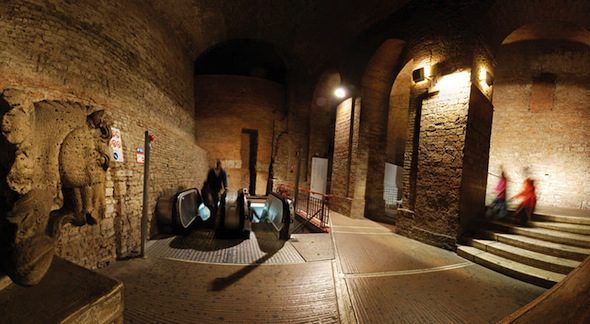
>> Scopri Perugia e la Rocca, contatta ora i migliori agriturismi della zona
Storia delle Rocca Paolina di Perugia
La fortezza della Rocca Paolina fu fatta erigere tra il 1540 e il 1543 da Papa Paolo III Farnese, dal quale prese il nome di “Paolina”, dopo aver sedato la rivolta nota come “Guerra del Sale” e sconfitto la Signoria dei Baglioni che qui aveva dimora.
Progettata dal noto architetto militare Antonio da Sangallo il giovane, la rocca venne costruita sul Colle Landone in posizione strategica per dominare il centro della città e difenderlo nel suo lato più scoperto. Sul colle sorgevano vari edifici di proprietà della famiglia Baglioni che vennero rasi al suolo, assieme alle case dell’attinente Borgo di Santa Giuliana, per farne materiali da costruzione. Gli edifici che invece ricadevano nell’area corrispondente al perimetro della fortezza vennero inglobati e ricoperti da ampie e possenti volte, andando a costituirne il piano interrato.
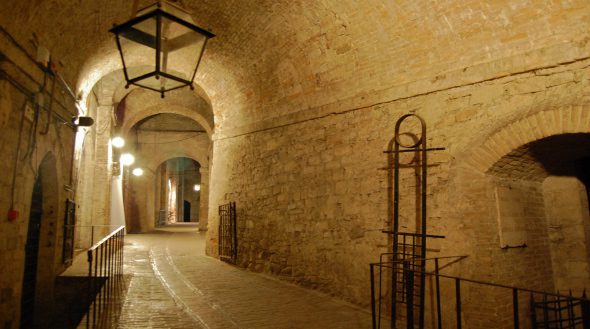
La costruzione dell’imponente Rocca deturpò inevitabilmente il profilo urbanistico di Perugia, città che all’epoca era descritta come tra le più belle d’Italia grazie alle sue oltre sessanta torri, la cerchia di mura etrusche, i palazzi signorili e le cattedrali. Grande merito dell’architetto Antonio da Sangallo fu comunque quello di aver salvato Porta Marzia, portale etrusco che venne fatto smontare e poi ricomporre incassato nelle mura del bastione di levante della Rocca, per decorarne un ingresso.
Vero e proprio simbolo del potere pontificio che dominò a Perugia per più di tre secoli, la Rocca Paolina fu fortemente osteggiata dai perugini e parzialmente distrutta una prima volta nel corso delle rivolte del 1848. Ricostruita nel 1860 per volontà di papa Pio IX, fu poi sistematicamente abbattuta man mano nei decenni successivi all’Unità d’Italia. Solo dopo gli anni ’30 iniziarono dei lavori di rimozione delle macerie e di ristrutturazione di quanto rimasto, in particolare i sotterranei e parte delle mura. Infine, nel 1965, quella “città sotterranea” di innegabile fascino venne infine restituita ai cittadini.
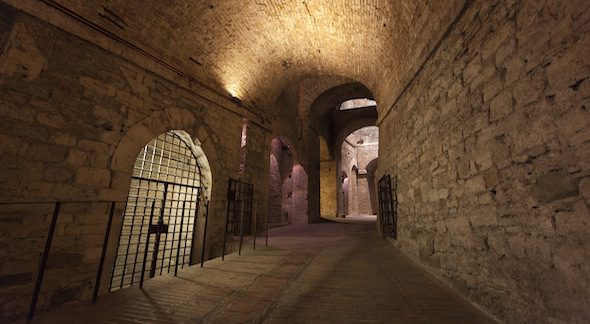
Cosa Vedere nella Rocca Paolina
L’antica fortezza si articolava in tre aree: il Palazzo Papale, il Corridore e la Tenaglia, che furono però demolite e sostituite da palazzi, tra cui l’attuale Palazzo della Pronvincia, e dai giardini nati sulle fondamenta medievali preesistenti alla rocca stessa.
Dimenticati per decenni, i sotterranei della Rocca vennero infine riportati alla luce ed è oggi possibile esplorare il cuore stesso della fortezza, con il suo susseguirsi di antiche viuzze e sale tipiche della Perugia Medievale. Oltre ai quartieri antichi ed i vicoli, si possono ammirare ancora la Sala delle Guardie Papali, la casa della Famiglia Baglioni e, prima di uscire nella parte inferiore della Rocca, i resti in pietra dell’antico “Giuoco del Pallone”, uno stadio di legno dove veniva praticato tale gioco. Vi si trova inoltre il Museo della Rocca Paolina, che ne ripercorre le vicende storiche.
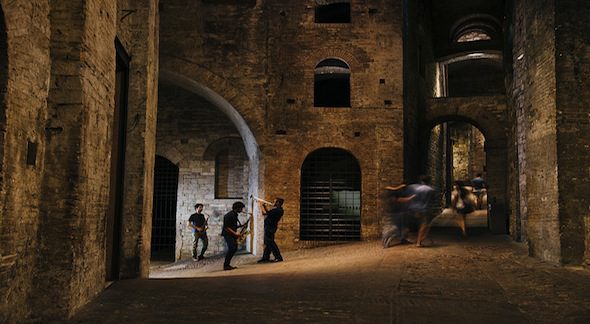
Passeggiare nella Rocca è un’emozione particolare, significa camminare in una città nella città, respirando l’atmosfera del tempo che fu. Gli spazi della Rocca costituiscono una ricchezza culturale di enorme valore e sono stati riqualificati a Centro Espositivo; qui vengono infatti ospitate mostre e attività culturali che ne esaltano ancora di più il fascino. Risalendo dal parcheggio si cammina tra piccoli negozi, esposizioni e un sito archeologico con i resti delle antiche case che sorgevano nell’area, per un vero e proprio tuffo nel passato.
Da ricordare poi l’antica Porta Marzia, la porta etrusca risalente al III secolo a.C. scampata alla distruzione, ancora oggi visibile. Ne rimangono in particolare l’arco a tutto sesto e il coronamento: ai lati dell’arco, due pilastri corinzi chiudono il coronamento formato da una sorta di loggia, sostenuto da pilastrini corinzi tra i quali sporgono tre mezze figure virili (Giove e i Dioscuri) e all’estremità due protomi di cavalli. Due fasce di pietra, inscritte a caratteri romani, chiudono sopra e sotto la loggia.
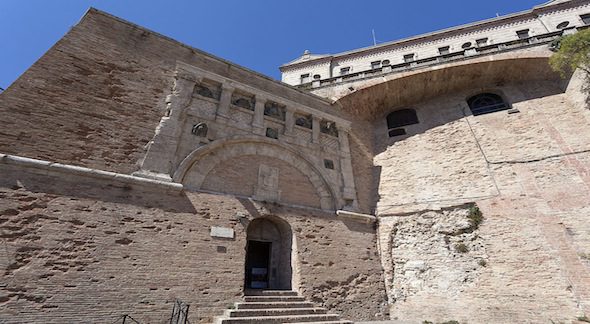
>> Ci sono offerte in scadenza! Clicca e consulta la lista dei migliori hotel nella zona di Perugia!
Visitare la Rocca Paolina e Perugia
La Rocca Paolina arricchisce la città e si modella sulle necessità dei perugini, assumendo denominazioni nuove in occasione degli eventi principali di Perugia. Durante Eurochocolate, ad esempio, la Rocca evoca il tema del cioccolato con il nome di “Rocca Pralina”. Mai deserta, la Rocca è parte integrante della città e costituisce un animato punto di riferimento per i cittadini e per i turisti durante le feste e nella quotidianità.
A Natale in particolare, con la manifestazione “Natale alla Rocca”, è allestita al suo interno una mostra-mercato natalizia con prodotti d’artigianato e decorazioni, dei mestieri d’arte e riciclo e specialità gastronomiche.
La Rocca è liberamente accessibile e visitabile negli orari di apertura delle scale mobili che da piazza Partiginani portano a Piazza Italia, dalle 06:15 alle 01:45.
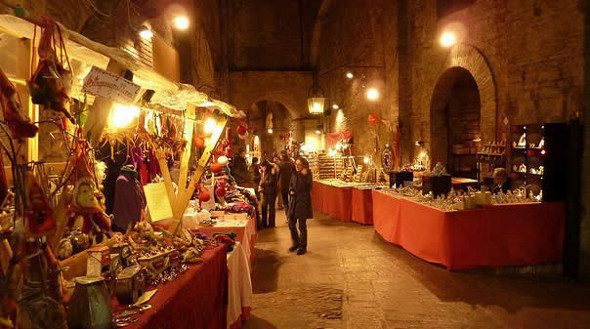
>>Se hai deciso di visitare Perugia e la Rocca Paolina, ti consigliamo di contattare ora gli agriturismi nelle sue vicinanze
In 1540, during the pontificate of the Farnese Pope Paul III, Perugia was last free city in Italy and was finally defeated in what is known as the Salt War. As a sign of the renewed papal dominion, the Pope commisioned Antonio da Sangallo the Younger to build an imposing fortress: Rocca Paolina.
>> Do you want to visit Rocca Paolina? Contact now the best farmhouse in Perugia and discover their offers!

The interior of the Rocca Paolina is formed by the ancient streets and squares of medieval Perugia. The escalators built inside facilitate the visit and quickly connect the lower part of the city with Corso Vannucci.
In addition to the old neighborhoods and streets, you can still see the hall of the papal guards, the house of the Baglioni family and, before exiting at the bottom of the fortress, the remains of ancient stone “Game of Football”, a stage of wood where the game was played. We should also mention the ancient Porta Marzia, the door of Etruscan circle (second half of the third century BC), which was set in the eastern bastion of the Rocca Paolina to decorate an entrance.
>> There are offers in deadline! Click and consult list of the best hotels in Perugia!

The Rocca Paolina supports the needs of citizens taking new names at the events and hosting festivals, social events and its own exhibition center (the CERP).
To visit it you do not pay the ticket, but along with its ancient rooms also live the Perugia dynamic and modern. Never deserted, the fortress is an integral part of the city: a vibrant reference point for citizens and tourists during the holidays and in everyday life.
>>If you’ve decided to see Perugia and to visit the Rocca Paolina you should contact Stuart now houses in its vicinity >>click this link
In 1540, during the pontificate of the Farnese Pope Paul III, Perugia was last free city in Italy and was finally defeated in what is known as the Salt War. As a sign of the renewed papal dominion, the Pope commisioned Antonio da Sangallo the Younger to build an imposing fortress: Rocca Paolina.
>> Do you want to visit Rocca Paolina? Contact now the best farmhouse in Perugia and discover their offers!

The interior of the Rocca Paolina is formed by the ancient streets and squares of medieval Perugia. The escalators built inside facilitate the visit and quickly connect the lower part of the city with Corso Vannucci.
In addition to the old neighborhoods and streets, you can still see the hall of the papal guards, the house of the Baglioni family and, before exiting at the bottom of the fortress, the remains of ancient stone “Game of Football”, a stage of wood where the game was played. We should also mention the ancient Porta Marzia, the door of Etruscan circle (second half of the third century BC), which was set in the eastern bastion of the Rocca Paolina to decorate an entrance.
>> There are offers in deadline! Click and consult list of the best hotels in Perugia!

The Rocca Paolina supports the needs of citizens taking new names at the events and hosting festivals, social events and its own exhibition center (the CERP).
To visit it you do not pay the ticket, but along with its ancient rooms also live the Perugia dynamic and modern. Never deserted, the fortress is an integral part of the city: a vibrant reference point for citizens and tourists during the holidays and in everyday life.
>>If you’ve decided to see Perugia and to visit the Rocca Paolina you should contact Stuart now houses in its vicinity >>click this link
In 1540, during the pontificate of the Farnese Pope Paul III, Perugia was last free city in Italy and was finally defeated in what is known as the Salt War. As a sign of the renewed papal dominion, the Pope commisioned Antonio da Sangallo the Younger to build an imposing fortress: Rocca Paolina.
>> Do you want to visit Rocca Paolina? Contact now the best farmhouse in Perugia and discover their offers!

The interior of the Rocca Paolina is formed by the ancient streets and squares of medieval Perugia. The escalators built inside facilitate the visit and quickly connect the lower part of the city with Corso Vannucci.
In addition to the old neighborhoods and streets, you can still see the hall of the papal guards, the house of the Baglioni family and, before exiting at the bottom of the fortress, the remains of ancient stone “Game of Football”, a stage of wood where the game was played. We should also mention the ancient Porta Marzia, the door of Etruscan circle (second half of the third century BC), which was set in the eastern bastion of the Rocca Paolina to decorate an entrance.
>> There are offers in deadline! Click and consult list of the best hotels in Perugia!

The Rocca Paolina supports the needs of citizens taking new names at the events and hosting festivals, social events and its own exhibition center (the CERP).
To visit it you do not pay the ticket, but along with its ancient rooms also live the Perugia dynamic and modern. Never deserted, the fortress is an integral part of the city: a vibrant reference point for citizens and tourists during the holidays and in everyday life.
>>If you’ve decided to see Perugia and to visit the Rocca Paolina you should contact Stuart now houses in its vicinity >>click this link
In 1540, during the pontificate of the Farnese Pope Paul III, Perugia was last free city in Italy and was finally defeated in what is known as the Salt War. As a sign of the renewed papal dominion, the Pope commisioned Antonio da Sangallo the Younger to build an imposing fortress: Rocca Paolina.
>> Do you want to visit Rocca Paolina? Contact now the best farmhouse in Perugia and discover their offers!

The interior of the Rocca Paolina is formed by the ancient streets and squares of medieval Perugia. The escalators built inside facilitate the visit and quickly connect the lower part of the city with Corso Vannucci.
In addition to the old neighborhoods and streets, you can still see the hall of the papal guards, the house of the Baglioni family and, before exiting at the bottom of the fortress, the remains of ancient stone “Game of Football”, a stage of wood where the game was played. We should also mention the ancient Porta Marzia, the door of Etruscan circle (second half of the third century BC), which was set in the eastern bastion of the Rocca Paolina to decorate an entrance.
>> There are offers in deadline! Click and consult list of the best hotels in Perugia!

The Rocca Paolina supports the needs of citizens taking new names at the events and hosting festivals, social events and its own exhibition center (the CERP).
To visit it you do not pay the ticket, but along with its ancient rooms also live the Perugia dynamic and modern. Never deserted, the fortress is an integral part of the city: a vibrant reference point for citizens and tourists during the holidays and in everyday life.
>>If you’ve decided to see Perugia and to visit the Rocca Paolina you should contact Stuart now houses in its vicinity >>click this link


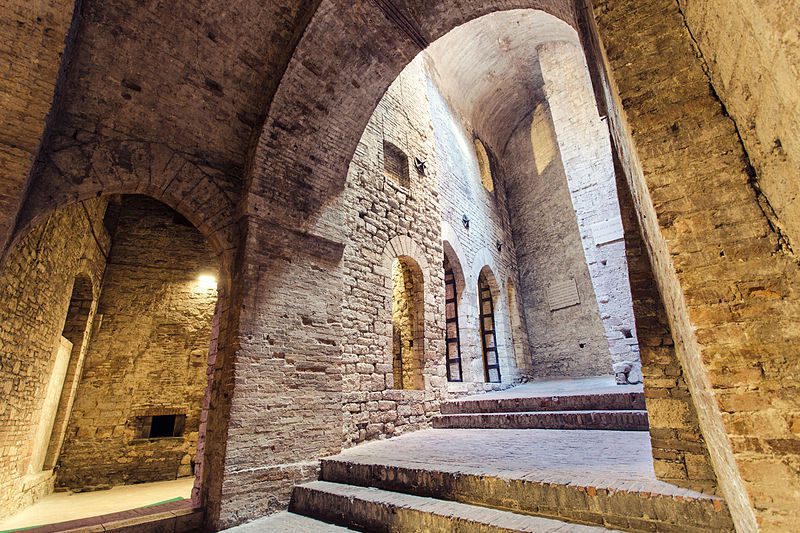






Comment (0)